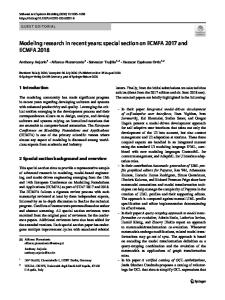Special Section on Clinical Research Standards Introduction
- PDF / 2,299,413 Bytes
- 3 Pages / 612 x 792 pts (letter) Page_size
- 33 Downloads / 293 Views
Paul Bleicher, Wayne Kubick, Rebecca Kusk, Guest Editors
Key Words Correspondence Address Rebecca Kush- cD'sc15907 Two Rivers Cove, Austin, TX 78717 (e-mail: [email protected]).
369
Special Section on Clinical Research Standards Introduction
The importance of adopting standards to support the exchange of data for global biopharmaceutical research and development has never been more important, and interest in this area has never been higher. Since the establishment of the Clinical Data Interchange Standards Consortium (CDISC) in 1997, we have seen significant momentum toward adoption of CDISC standards among sponsors, as evidenced by growing membership in this nonprofit organization, vastly increased attendance at standardsrelated training courses, and especially a rapidly increasing community of highly motivated participants contributing to standards development efforts. The US Food and Drug Administration (FDA) has done much to build some of this momentum by specifying the use of certain standards in several different areas and in recognizing the establishment of standards as one of their critical path objectives. However, sponsors have also been motivated to increase their adoption of data standards, not only to improve interactions with partners and to realize substantial cost and time savings in their research processes but also to improve team communication and data quality and to develop valuable repositories of knowledge. In addition, standards to enable the interchange of information between research and health care are of strategic interest to biopharmaceutical product development companies and academic research
institutions to facilitate the investigator role in clinical research. Meanwhile, the global standards-development landscape has become increasingly complex, involving an ever-broadening cast of stakeholders with many different objectives. Since its initiation, CDISC has enjoyed a niche for standards development within the clinical research domain, and since 2001, the efforts of CDISC have become closely aligned with the relevant activities within the primary health care standards development organization, Health Level Seven (HL7). These standards-development organizations are also represented within government initiatives such as the movement toward electronic health records now under way in many countries, and they are both committed to harmonizing the clinical research standards with relevant health care standards. At the same time, the pace of technology advancement continues to accelerate, and the process of creating standards has become more rigorous and sophisticated using advanced modeling concepts. Perhaps, most importantly, the focus of standards development efforts has moved beyond the original goal of establishing simple syntactic data interchange standards toward full semantic as well as syntactic interoperability, a large part of which is based on defining a robust set of controlled terminology, "the words that populate the structures." To achieve
Drug Informntion J o l m dDownloa
Data Loading...











